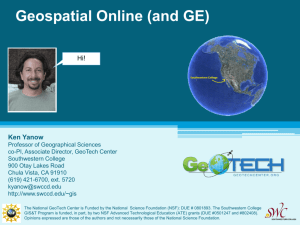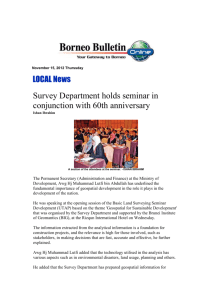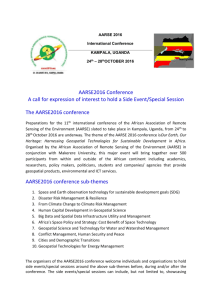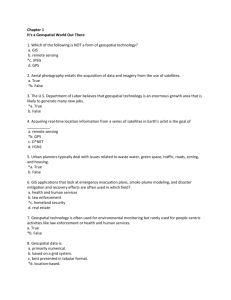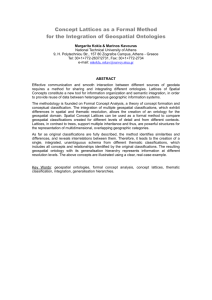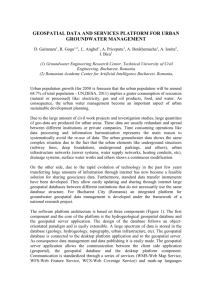Trends in Technology and the future direction of data creation
advertisement
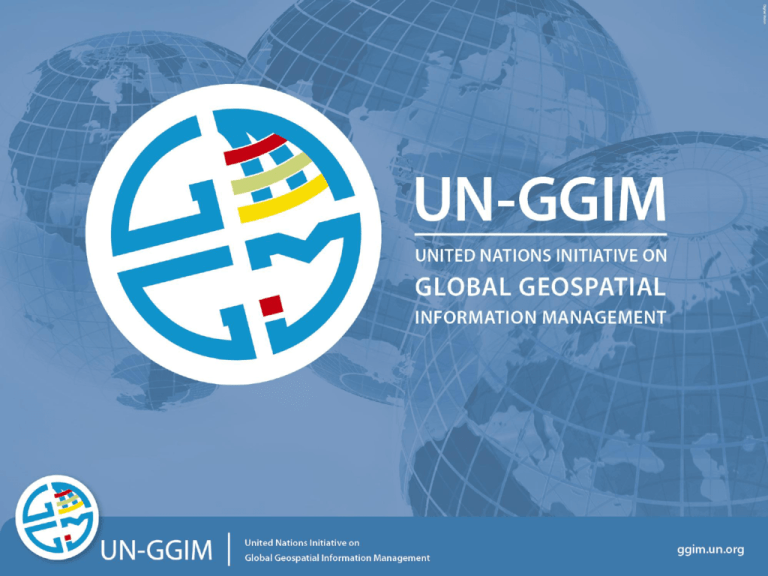
Trends in technology and the future direction of data creation, maintenance and management Trends in Technology and the future direction of data creation, maintenance and management • Everything will be, in some sense, a geospatial beacon, referencing to or generating location information. • Location information as “Analytical superfood” that can and will, if used effectively and appropriately, improve people’s lives across the globe. Trends in Technology and the future direction of data creation, maintenance and management • Growth in the amount of data (approximately 2.5 quintillion bytes created per day) brings with it an ever-growing requirement to be able to find the right information at the right time. • The demand for real-time information and real-time modelling available through social media and other web uses, seems certain to increase over the coming years and presents real challenges. Trends in Technology and the future direction of data creation, maintenance and management • Given the amount of data already generated and the fact that this amount will continue to grow, the importance of linking data together, particularly by location, is likely to grow. • A hyper-connected environmentestimates suggest over 50 billion things connected by 2020. • Real geospatial management challenges to feed the increasing demand to exploit this information - in real-time. Trends in Technology and the future direction of data creation, maintenance and management • Massive shift in how geospatial information managed, hosted, served and how it is consumed. • Use of the cloud will become the norm, enabling the desired information accessible to anyone, anywhere, anytime, available on the device of your choice. Trends in Technology and the future direction of data creation, maintenance and management • Value of open source will grow as more users adopt and feedback improvements. • Three trends likely to drive adoption: 1. where resources are scarce or provides best expertese; 1. ability to modify and share easily, and build common user communities; 2. future geospatial leaders exposed at early stage to the use of open source and so already culturally attuned. Trends in Technology and the future direction of data creation, maintenance and management • The trend of moving from 2D mapping through to 3D and on to 4D visualisations is technology-driven and will accelerate. • Users will expect much more complex and realistic models, to enable effective planning and management and to optimise resources. Trends in Technology and the future direction of data creation, maintenance and management • Unmanned Aerial Vehicles (UAVs) are likely to be increasingly used. An additional method of data capture on its own, and also to complement existing methods of aerial and satellite remote sensing. • The ease-of-use, speed of capture, and ability to access difficult areas means they are of particular use in emergency response situations or where real-time information is of particular value to those on the ground. Trends in Technology and the future direction of data creation, maintenance and management • Quality of aerial and satellite imagery will continue to increase. • However, with existing availability of high resolution in many areas of the globe already, focus is likely to be on speed of acquisition and dissemination rather than on the quality. • Indoor positioning is an emerging area of interest Trends in Technology and the future direction of data creation, maintenance and management • Launch of new and next generation GNSS will enable faster data collection, with higher accuracy and greater integrity. • Improved satellite technologies are starting to challenge the way vertical reference systems are defined. • Interoperability and unification of geospatial information datasets across the globe will become increasingly important. Legal and policy developments Legal and policy developments • Access to government generated geospatial information free at the point of use is likely to continue – but availability will be determined by the business models of the countries. • One of the greatest policy change will be the drive to improve quality of core geospatial information, while securing funding to develop and maintain it. • Maintenance of data costs money! What are the funding models that mean that data can be maintained and released as open data? Legal and policy developments • Traditional funding models may require radical change. • Role of NMCAs will move towards demonstrating value and securing funding. • Reductions in central government funding will necessitate more active collaboration with the private sector. Legal and policy developments • Who owns the data? • What is the model for investing in and maintaining new and expensive content? • Establishment of trans-national frameworks needed to overcome the increasing trend in data piracy and hacking. Legal and policy developments • Individual’s right to privacy, consumer protection and marketing laws need to evolve to enable each citizen to enjoy appropriate protections. • Increasing demand for global frameworks that need to enable consistent, trans-border legal protections for individuals. • Getting the best from volunteer geospatial community and government – a clear goal over the next five years. Legal and policy developments • Where does liability lie – if the trend in litigation and seeking legal redress for data issues grows? • Technology develops without boundaries; whereas legal and policy frameworks, confined by national boundaries, are not developing in a consistent way. • Development of consistent and transparent legal and policy frameworks – in areas such as privacy, national security, liability and intellectual property – are required. Skills requirements and training mechanisms Skills requirements and training mechanisms • Premium for highly skilled data modellers – with a range of competencies and ability to understand complex and time based data must be a priority. • Global networked communities. Skills requirements and training mechanisms • Research and development into new methods of cartography – particularly to facilitate display on different devices e.g. mobile, 3D TV • More collaboration between NMCAs and the design and creative industries, to harness visualisation skills in a way which enables geospatial information to be presented in the most appropriate means to inform decision makers. Skills requirements and training mechanisms • Policy and decision makers, to the very highest levels of governments and NGOs will need education in the value of using geospatial information as a building block of base infrastructure of each nation • Wider range of professional, academic and in-business approaches, in collaboration with leading NMCAs, to develop a global skills base. Skills requirements and training mechanisms • Investment in Research and Development (R&D) will continue to be vital. • Areas of particular interest should include: More effective and automatic processing of sensor data Development of location based applications and integration of high volumes of unstructured data Investing in early stage prototyping, testing and evaluating in emerging areas means opportunities can be realised at the earliest opportunity – and is more widely understood within a range of organisations. 1. 2. 3. The role of the private and non-governmental sectors The role of the private and non-governmental sectors • The private sector has made geospatial information accessible to the masses. • The increasing demand for trans-border information have, in many parts, been met by the private sector. The role of the private and non-governmental sectors • Government will likely remain the largest customers and commissioning agents for private sector geospatial information. • Private sector will face challenges – for example, creating and finding opportunities outside the government and NGO markets, and funding models will increasingly need to be driven by either value add-ons, or through other means. • Government release of open data, means the private sector may have to focus elsewhere in the value chain, and will likely lead to greater public-private partnerships. The role of the private and non-governmental sectors • Volunteer Geographic Information (VGI) may act as a valuable mechanism to encourage public participation and engage and empower citizens. • User led VGI and crowd sourced methods, in active partnerships with the NMCAs, may lead the way in how these methods are integrated most effectively. The role of the private and non-governmental sectors • VGI has the potential to enable a user’s view of their environment, which if utilised by policy and decision-makers, will allow for potentially more effectively targeted interventions and more tailored public services. The role of the private and non-governmental sectors • VGI bring many benefits, and its use is likely to continue growing – it will be in addition to, NOT replacement of, a wide range of quality-assured, maintained geospatial information from other sources. The future role of governments in geospatial data provision and management The future role of governments in geospatial data provision and management • Unlikely to wholly rely on data from the private sector and VGI community. • Unique position to consider geospatial information requirements for society as a whole. • Government has a key role to facilitate collaboration between all ‘actors’ and support all sources of information. The future role of governments in geospatial data provision and management • Bridging the gap between authoritative and crowd sourced data. • Moving away from competition and more towards collaboration or “coopetition” The future role of governments in geospatial data provision and management • Increase in the number of sources of geospatial information will challenge NMCAs, forcing a reconsideration of the traditional role played by government in collection of and provision of geospatial data. The future role of governments in geospatial data provision and management • End-users should be able to consume government-assured spatial data with the level of trust in quality as they do when they get water from the tap – they are going to get what they expect. Future trends in geospatial information management: the five to ten year vision
